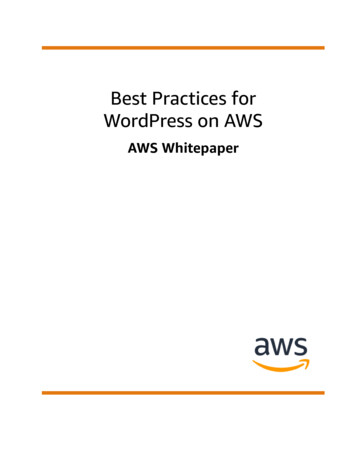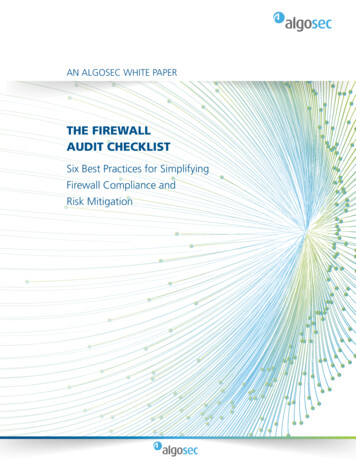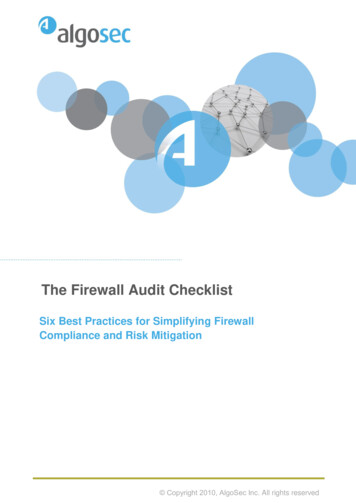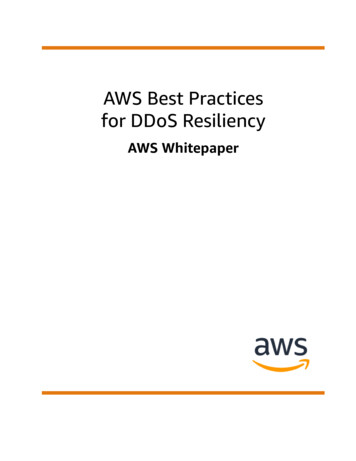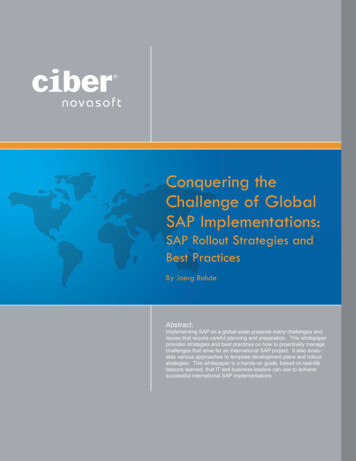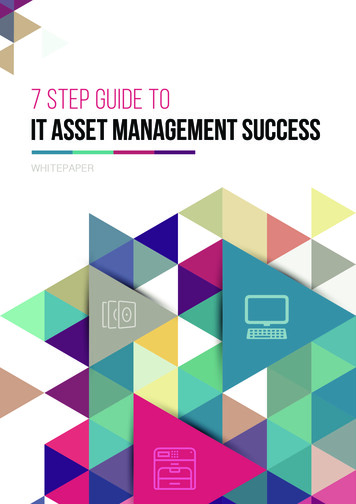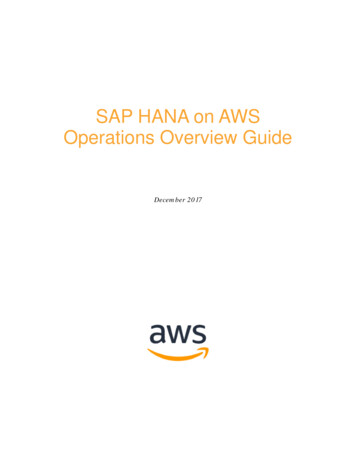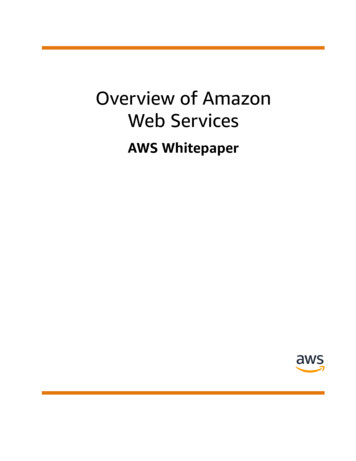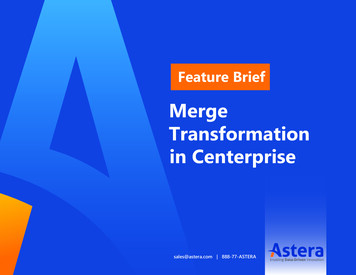
Transcription
An AlgoSec WhitepaperMANAGE SECURITY AT THE SPEED OF BUSINESSAlgoSec Whitepaper
The Need to Ensure Continuous ComplianceMore Regulations and standards relating to information security, such as the Payment Card IndustryData Security Standard (PCI-DSS), Sarbanes-Oxley, ISO 27002, and others have put more emphasis oncompliance and the regular auditing of security policies and controls. While regulatory and internalaudits cover a broad range of security checks, the firewall is featured prominently in them since it is thefirst line of defense between the public and the corporate network.Even if you do not have to comply with specific government or organizational standards, it is nowcommonplace -- and often mandatory -- that you conduct regular, thorough audits of your firewalls. Thisnot only helps ensure that your firewall configuration meets the correct criteria for an external standardor internal security policy, but a firewall audit can also play an important role to reduce overall riskfactors and actually improve firewall performance by its inclusion of certain tasks such as optimizing yourfirewall rule base.In today’s complex, multi-vendor network environments, which typically include thousands of firewallrules, the ability to complete a manual audit of your firewall has become nearly impossible. When thisprocess is conducted manually, the firewall administrator has to rely on his own experience andexpertise — which can vary greatly across organizations — to determine if a firewall rule should orshould not be included in the configuration file. Furthermore, if performed manually, documentation ofrules and/or rule changes is usually lacking. The time and resources required to pour through all of thefirewall rules and determine compliance/non-compliance significantly impacts IT staff.Automating the firewall audit process is crucial as compliance must be continuous, not simply a point intime. Firewall audits require that each new rule is pre-analyzed and simulated prior to beingimplemented, and that a full audit log of the change is created. Addressing this type of compliancerequirement without sound processes and automation is extremely difficult.THE FIREWALL AUDIT CHECKLIST 2
The Firewall Audit ChecklistThe following is a checklist of six best practices for a firewall audit based on AlgoSec’s experience inconsulting with some of the largest global organizations and auditors on firewall audit, optimization andchange management procedures. This should not be viewed as an exhaustive list, but it does provideguidance on some critical areas to cover when conducting a firewall audit.Figure 1: Overview of the Recommended Firewall Audit Process1. Gather Key Information Prior to Starting the AuditAn audit has little chance of success without having visibility of your network, including software,hardware, policies and risks. The following are examples of key information required to plan the auditwork:a. Obtain copies of relevant security policies.b. Obtain access to firewall logs that can be analyzed against the firewall rule base tounderstand what is actually being used.c. Obtain a diagram of the current network and firewall topologies.d. Obtain reports and documents of previous audits, including firewall rules, objects and policyrevisions.e. Identify all Internet Service Providers (ISP) and Virtual Private Networks (VPN).f. Obtain all relevant firewall vendor information including OS version, latest patches anddefault configuration.g. Understand all the key servers and key information repositories in the network and theirrelative values to the company.THE FIREWALL AUDIT CHECKLIST 3
Once you have gathered this information, how are you aggregating it and storing it? Spreadsheetcompliance is a surefire way to make the audit process painful. You need to document, store andconsolidate this important information in a way that enables collaboration with your IT counterparts.Then you can start reviewing policies and procedures and tracking their effectiveness in terms ofcompliance, operational efficiency and risk mitigation.2. Review Your Change Management ProcessA good change management process is essential to ensure proper execution and traceability of firewallchanges, as well as sustainability over time to ensure continuous compliance vs. point-in-timecompliance. Poor documentation of changes, including why the change is needed, who authorized thechange, etc. and poor validation of the impact on the network are two of the most common issues whenit comes to change control.a. Review the procedures for rule-base maintenance. Just a few key questions to review include: Are requested changes going through proper approvals? Are changes being implemented by authorized personnel? And are they being tested? Are the changes being documented per regulatory or internal policy requirements? Each ruleshould have a comment that includes the change ID of the request and the name/initials ofthe person who implemented the change. Is there an expiration date for the change?b. Determine if there is a formal and controlled process in place to request, review, approve andimplement firewall changes. Note: This process should include at least the following:a) Business purpose for requestb) Duration (time period) for new/modified rulec) Assessment of the potential risks associated with the new/modified ruled) Formal approvals for new/modified rulee) Assignment to proper administrator for implementationf) Verification that change has been tested and implemented correctlyc. Determine whether or not all of the changes have been authorized, and flag any unauthorizedrule changes for further investigation.d. Determine if real-time monitoring of changes to the firewall is enabled and access to rule changenotifications is granted to authorized requestors, administrators and stakeholders.THE FIREWALL AUDIT CHECKLIST 4
3. Audit the Firewall Physical and OS SecurityThis is important to help protect against the most fundamental types of attack.a. Ensure firewall and management servers are physically secured with controlled access.b. Ensure there is a current list of authorized personnel permitted to access the firewall serverrooms.c. Verify that all appropriate vendor patches and updates have been applied.d. Ensure the operating system passes common hardening checklists.e. Review the procedures used for device administration.4. Cleanup and Optimize Your Rule BaseRemoving firewall clutter and optimizing the rule base can greatly improve IT productivity and firewallperformance. Additionally, optimizing firewall rules can significantly reduce a lot of unnecessaryoverhead in the audit process.a.b.c.d.e.Delete covered rules that are effectively useless.Delete or disable expired and unused rules and objects.Identify disabled, time inactive and unused rules which are candidates for removal.Evaluate the order of firewall rules for effectiveness/performance.Remove unused connections, including specific source/destination/service routes that are not inuse.f. Detect similar rules that can be consolidated into a single rule.g. Identify overly permissive rules by analyzing the actual policy usage against the firewall logs.Tune these rules as appropriate for policy and actual real use scenarios.h. Analyze VPN parameters to identify unused users, unattached users, expired users, users aboutto expire, unused groups, unattached groups and expired groups.i. Enforce object naming conventions.j. Document rules, objects and policy revisions for future reference.5. Conduct a Risk Assessment and Remediate IssuesEssential for any firewall audit, a comprehensive risk assessment will identify risky rules and ensure thatrules are compliant with internal policies and relevant standards and regulations.a. Identify any and all potentially “risky” rules, based on industry standards and best practices, andprioritize them by severity. What is “risky” can be different for each organization depending onthe network and the level of acceptable risk, but there are many frameworks and standards youcan leverage that provide a good reference point. A few things to look for and validate include: Are there firewall rules that violate your corporate security policy? Are there any firewall rules with “ANY” in the source, destination, service/protocol,application or user fields, and with a permissive action? Are there rules that allow risky services from your DMZ to your internal network? Are there rules that allow risky services inbound from the Internet?THE FIREWALL AUDIT CHECKLIST 5
b.c.d.e.Are there rules that allow risky services outbound to the Internet?Are there rules that allow direct traffic from the Internet to the internal network (not theDMZ)? Are there any rules that allow traffic from the Internet to sensitive servers, networks,devices or databases?Analyze firewall rules and configurations against relevant regulatory and/or industry standardssuch as PCI-DSS, SOX, ISO 27001, NERC CIP, Basel-II, FISMA and J-SOX, as well as corporatepolicies that define baseline hardware and software configurations to which devices mustadhere. See Figure 4 below.Document and assign an action plan for remediation of risks and compliance exceptions found inrisk analysis.Track and document that remediation efforts are completed.Verify that remediation efforts and any rule changes have been completed correctly.6. Ongoing AuditsNow that you have successfully audited your firewalls and security devices and secured theirconfiguration, you need to ensure the proper steps are in place to ensure continuous compliance.a. Ensure a process is established for continuous auditing of firewalls.b. Consider replacing error-prone manual tasks with automated analysis and reporting.c. Ensure all audit procedures are properly documented, providing a complete audit trail of allfirewall management activities.d. Make sure that solid firewall change workflow is in place to sustain compliance over time.Note: This is purposely repetitive from Audit Checklist item #2 because without changemanagement, you won’t be able to ensure continuous compliance – you will go through thecleanup and optimization at a point in time, but a month later you may no longer be compliant.e. Ensure there is an alerting system in place for significant events or activities, such as changes incertain rules or the discovery of a new, high severity risk in the policy.THE FIREWALL AUDIT CHECKLIST 6
Automating Firewall Compliance Audits with AlgoSecWhen it comes to compliance, you want to ensure that your firewall policy management solution has thebreadth and depth to automatically generate detailed reports for multiple regulations and standards,and support multiple firewalls and related security devices.By combining this firewall audit checklist with a solution such as the AlgoSec Security ManagementSolution, and you can significantly improve your security posture and reduce the pain of ensuringcompliance with regulations, industry standards and corporate policies. Furthermore, you can ensurecontinuous compliance – without spending significant resources pouring through complex securitypolicies on a regular basis. Let’s go back through the checklist and look at a few examples of how AlgoSeccan help.Gain Visibility of and Changes to Your Network PoliciesAlgoSec enables you to gather all of the key information you need to be able to start the audit process.By generating a dynamic, interactive network map AlgoSec can help you visualize and analyze complexnetworks as seen below in Figure 2 – you can view routing tables and automatically detect all interfaces,subnets and zones. Additionally, AlgoSec provides you with visibility of all changes to your networksecurity policies in real-time and creates detailed firewall audit reports to help approvers make informeddecisions about changes that affect risk or compliance levels.Figure 2: AlgoSec provides network topology awareness and a topology map provides visibility of all firewalls androuters including all relevant interfaces, subnets and zones, with the ability to drill down to specific informationabout each device.THE FIREWALL AUDIT CHECKLIST 7
Understand the Firewall Changes in Your Network – and Automate the Process!AlgoSec intelligently automates the security policy change workflow, dramatically cutting the timerequired to process firewall changes, increasing accuracy and accountability, enforcing compliance andmitigating risk. AlgoSec also provides flexible workflows and templates to help you better managechange requests and tailor processes to your specific business needs.Clean Up and Optimize Your Rule BaseAlgoSec enables you to optimize and clean up cluttered policies with actionable recommendations to: Consolidate similar rulesDiscover and remove unused rules and objects (see figure 4)Identify and remove shadowed, duplicate, and expired rulesReorder rules for optimal firewall performance while retaining policy logicTighten overly permissive rules based on actual usage patternsNot only does this help you improve the performance and extend the life of your firewalls, it also savestime when it comes to troubleshooting issues and IT audits.Figure 4: This example shows unused rules that AlgoSec has identified for removal.Conduct a Risk Assessment and Remediate IssuesAlgoSec enables you to instantly discover and prioritize all risks and potentially risky rules in the firewallpolicy, leveraging the largest risk knowledgebase available, which includes industry regulations, bestpractices, and customizable corporate security policies. It assigns and tracks a security rating for eachdevice and group of devices to help you quickly pinpoint devices that require attention and measure theeffectiveness of a security policy over time.THE FIREWALL AUDIT CHECKLIST 8
Figure 5: AlgoSec identifies and prioritizes risky rules based on industry standards and frameworks and providesdetailed information of source, destination, service, as well as user and application when analyzing next-generationfirewalls.Out-of-the-Box Compliance ReportsAlgoSec ensures continuous compliance and instantly provides you with a view of your firewallcompliance status by automatically generating reports for industry regulations, including PCI - DSS(Payment Card Industry Data Security Standard), SOX (Sarbanes-Oxley), J-SOX (Financial Instruments andExchange Act, also known as “Japan-SOX), NERC CIP (North American Electric Reliability CorporationCritical Infrastructure Protection), and ISO-27001 (International Organization for Standardization). If thenetwork security policy doesn’t adhere to regulatory or corporate standards, the reports identify theexact rules and devices that cause gaps in compliance. A single report provides visibility into risk andcompliance associated with a group of devices (see figure 6).THE FIREWALL AUDIT CHECKLIST 9
Figure 6: Example of a PCI DSS firewall compliance report automatically generated by AlgoSec.THE FIREWALL AUDIT CHECKLIST 10
ConclusionEnsuring compliance and being able to prove it typically requires significant organizational resources andbudget. Armed with the firewall audit checklist and with a security policy management solution such asAlgoSec, you can:Reduce the time required to undergo an auditManual reviews can take a significant amount of time to produce a report for each firewall in thenetwork. AlgoSec aggregates data across a defined group of firewalls and devices for a single complianceview, instead of running reports for each individual device, saving a tremendous amount of time andeffort that may be wasted on collating individual device reports. AlgoSec enables you to produce a reportin minutes, reducing time by as much as 80%.Reduce the cost of complianceAs the auditor’s time to gather pertinent information and analyze the network security status is reduced,the audit cost decreases substantially. Additionally, AlgoSec facilitates the remediation of non-compliantitems by providing actionable information, reducing the time to regain a compliant state and thus savingcosts.Marc Silver, Security Manager, Discovery SATHE FIREWALL AUDIT CHECKLIST 11
About AlgoSecAlgoSec simplifies, automates and orchestrates security policy management to enable enterpriseorganizations and service providers to manage security at the speed of business. Over 1,500 of theworld’s leading organizations, including 15 of the Fortune 50, rely on AlgoSec to optimize the networksecurity policy throughout its lifecycle, to accelerate application delivery while ensuring security andcompliance. AlgoSec is committed to the success of each and every customer, and provides theindustry’s only money-back guarantee.For more information visit http://www.AlgoSec.com or visit our blog.Global Headquarters65 Challenger Road,Suite 320Ridgefield ParkNJ 07660, USA 1-888-358-3696 Copyright 2015, AlgoSec Inc. All rights reserved.EMEA Headquarters80 Coleman StreetLondon EC2R 5 BJUnited KingdomTel: 44 207-099-7545APAC Headquarters10 Anson Road, #14-06International PlazaSingapore 079903 65-3158-2120AlgoSec.com
THE FIREWALL AUDIT CHECKLIST 5 3. Audit the Firewall Physical and OS Security This is important to help protect against the most fundamental types of attack. a. Ensure firewall and management servers are physically secured with controlled access. b. Ensure there is a current list of authori
